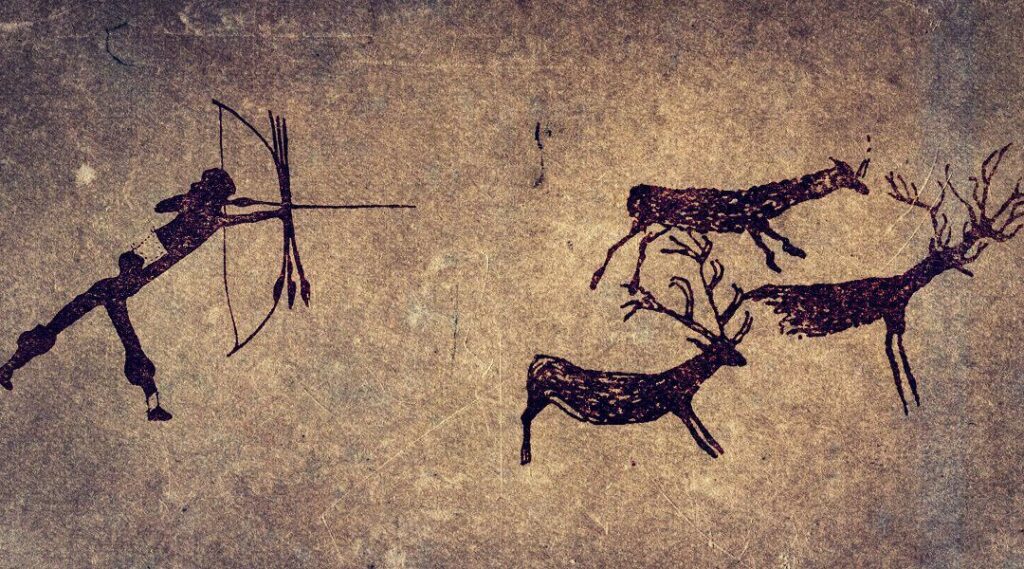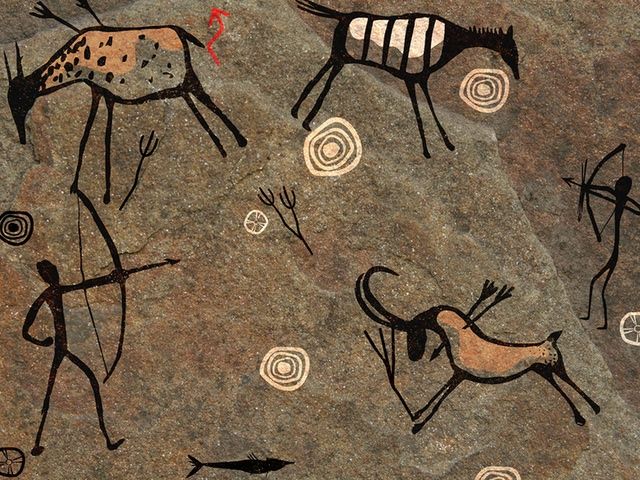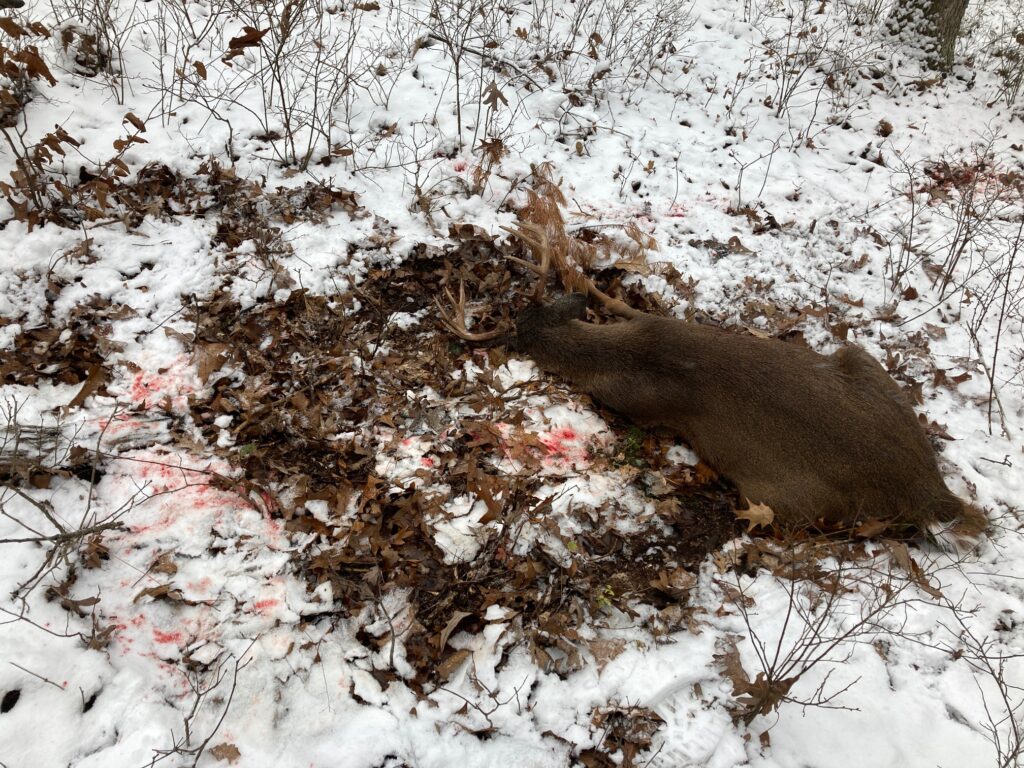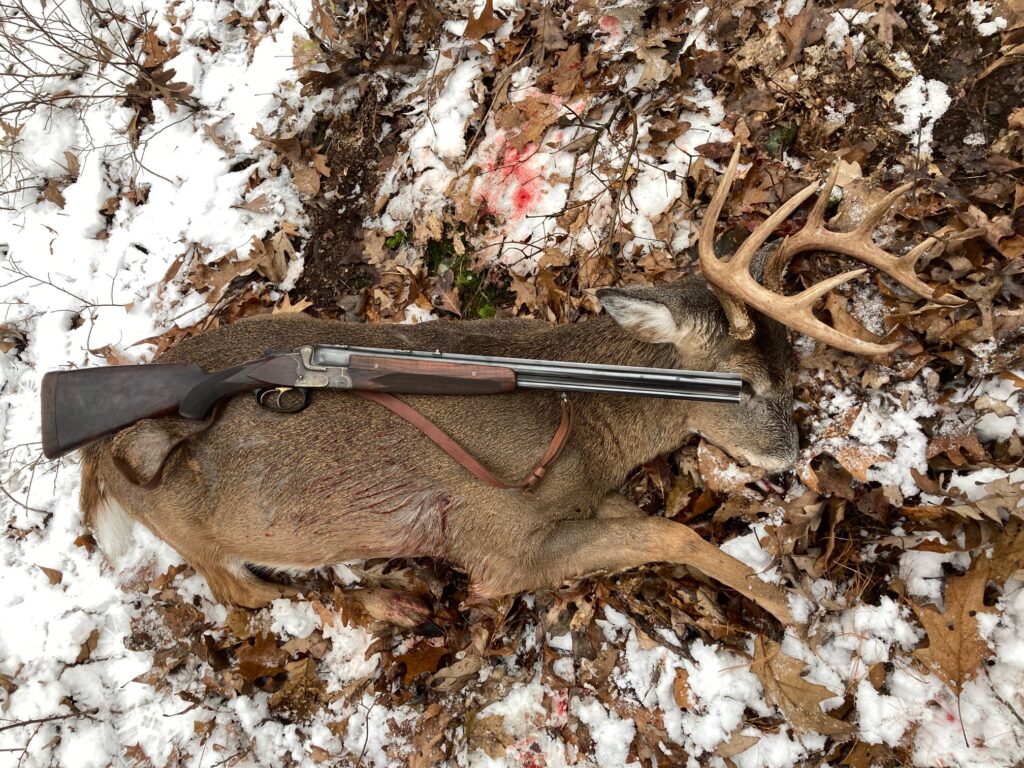Posts Tagged → scope
Primitive hunting techniques are more important than ever
In this day and age of popular stainless steel and plastic hunting rifles and Hubble telescope-sized rifle scopes, primitive hunting techniques and weapons are more important than ever. Something in the bad age of video games and instant gratification happened to the American character in the past thirty years or so, and so many young Americans have become lazy and even a bit heartless, as a result. Hunting culture has suffered from this, too. Really badly. Today’s focus seems to be predominantly on the kill, and much less on the process of the hunt.
Those curious about the distinction here should look up some neat videos from real hunters in the big woods of Vermont, Pennsylvania, and the Adirondacks.
Hunting should never be just about, or mostly about, killing an animal. Especially if the hunter wants to call it a trophy and put it up on his or her wall as a representation of his skill.
People trying to justify 300, 400 yard long range shots (or farther) on unsuspecting animals are not hunting, they are assassinating. Their wood craft often sucks, their field craft is limited to wearing camouflage, and their knowledge of the game animal is negligible. They are not really hunters, but rather shooters. Their high-tech guns, ammo, and rifle scopes are a crutch diminishing their need for good woodcraft, and it also results in a lack of appreciation for an actual hunt, and a lower value placed on the animal.
Culling oversized wild animal populations for the benefit of the environment is one thing, but hunting wild animals for pleasure and clean meat should be accomplished with skill. Age-old skills that everyone can respect. Hard-won wild animals taken with real skill under fair chase conditions are all trophies.
An unsuspecting big game animal assassinated at long range (or worse, inside a high fence, or over bait) requires very little hunting skill, and can never be said to be a trophy that is reflective of the hunter’s skill set. And yet isn’t this why so many hunters want big antlers and broad hides? They see these big animals as a reflection of their hunting prowess, of their manhood, their chest-thumping status within the outdoors community. As a result, America has developed a hunting culture driven by bigger-is-better trophies, at any cost, all too often achieved through long-range assassinations of unsuspecting wildlife, or over bait. Fair chase, which has always been at the heart of hunting, has been tossed away in favor of quick gratification and unfounded ego bragging rights.
The primary reason why primitive hunting weapons are so important today, is that someone has to keep the culture of hunting alive. What is a primitive hunting weapon? Pretty much any legal implement that requires the hunter to work hard to develop unique field craft/ wood craft skills, including the ability to penetrate within a fairly close range of the prey animal’s eyes, ears, and nose: Any bow (compound bow, stick bow, self bow, longbow, or other hand-held vertically limbed bow), spear, atl-atl, open-sighted black powder or centerfire rifle, any large bore handgun with or without a scope, should qualify. Flintlocks, percussion cap black powder muzzleloaders, and traditional bows are especially challenging to master and to harvest wild game with.
All of these primitive weapons require the hunter to actually hunt, to rely upon his woodcraft to carry him quietly and unseen across the landscape, and into a fair and close range of his prey animal. Animals taken with primitive weapons and techniques are earned in every way, and therefore they are fully appreciated.
Few experiences bother me more than watching some internet video of a fourteen year-old hunter running his hands over the antlers of a recently deceased buck, and listening to this inexperienced mere child discuss the finer aspects of this rack, its inches, its points, its relative size, and its (barf on my feet) trail camera name. Usually the child has shot the deer from an elevated box blind that conceals all of the hunter’s scent, sound, and movement. Whoever has taught these kids to hunt this way exclusively, and to then look at deer harvested this way as so many bragging rights, has done a huge disservice to these kids. These kids are going to grow up into poachers and baiters, always trying to prove how great of a “hunter” they are, and how studly and manly they are, at any cost. They will end up doing anything to score the next “record book” animal. These young kids who are being warped right now with this trophy nonsense are the future of America’s hunting culture, and what a crappy culture it will be if it is dominated by big egos and even bigger mouths armed with sniper rifles and no actual hunting skill.
Moms, dads, grandpas and uncles who are beginning to teach kids to hunt right now can do two simple things that will ensure their little student grows up into an ethical, responsible, high quality, law-abiding hunter: Make them use open sights on single-shot firearms and bows.
The skills that young hunters develop from having to rely on open sights and single shots (primitive weapons) will force them to achieve a high level of field craft, wood craft, and fair chase values. Developing skill requires a person to overcome challenges and adversity, often making mistakes along the way. And that results in better character.
Forcing kids to get close to their prey animal, and to take only carefully aimed shots with just open sights, will result in people who become really excellent hunters. Adults can always opt to add a scope to their rifle as their eyes age, but the lessons learned early on in concealment, controlling movement, playing wind direction, and instinctive shooting will keep the respectable art of hunting alive and well.
This Fall, get your little one started on a flintlock or old Fred Bear recurve bow from the get-go, for squirrels and deer, and watch as a true hunter is born.
What is hunting?
With hunting seasons drawing to a close here in Pennsylvania, it is worth the time to revisit an old question, which is What is hunting?
We ask because, without question, non-hunters overwhelmingly support hunting that is fair chase and purposeful. That is, hunters who are seen by the public to be respectful of our prey are recognized as a positive force, and worthy of continuing their pastime.
Every scientific opinion survey asking Americans their opinion about this subject for the past several decades has yielded the same result: Hunters who actually hunt get respect and support from non-hunters. On the other hand, people who are perceived by the general public to be casually killing animals just for pleasure or for “trophies” usually do not garner much support.
While there is a lot for us to talk about with even just the survey question itself, like how America has become so urbanized and thus our people so distant from the natural resources and processes that feed and clothe us and wipe our butts (toilet paper from trees harvested in forests) etc, this particular question, and its answer, is most important because hunters are a minority of a minority in America.
Positive public opinion about hunters and hunting is necessary to the continuation of regulated hunting as we know it and as it has been practiced for the past 100 years.
Given that American hunters are lamentably awash in a sea of soulless plastic and stainless steel rifles these days, whereupon the Hubble Telescope-equivalent scope is mounted, many owners of these contraptions are regularly and quite naturally tempted to attempt military-grade long distance sniper assassinations of far-off big game animals.
Though fleet of foot, strong of heart, and equipped with majestically sensitive noses, ears, and eyes, these animals cannot compete with humans who are so far removed from the natural zone of awareness these animals’ senses otherwise provide them. This begs the question of whether or not long-long-distance shots at these clueless animals are actual fair chase hunting, or are they incautious and disrespectful maltreatment of animals we otherwise admire.
Honestly, this stark question brings to my mind the images of charismatic megafauna hand-painted on cave walls by our spear-wielding ancestors: Rhinos, gigantic cave bears, massive aurochs, lions, zebras and wild horses, bison, etc. dangerous animals all, taken at great personal risk and at bad breath distance, contrasted with today’s ego-driven high-fence “trophies” mounted on manicured man cave walls around America, animals snuffed out without a chance at fight or flight. The cave paintings were the Sistine Chapel experience for paleolithic humans, and today’s manicured egocentric faux trophy rooms are very sorry substitutes. Authentic versus fake, they couldn’t be more different from one another.
So, a bear or deer taken with a bow, a crossbow, a spear, an atlatl, a blowgun, a shotgun, a flintlock or percussion muzzleloader, or a modern muzzleloader or rifle with open sights seems like a pretty natural example of fair chase. The 400-yard Hubble Telescope plus “500 Magnum Killem” caliber assassination of the unknowing and unsuspecting beast is just that, an assassination. Is there anything fair or chase about it?
Just as political America now requires a return to our simple and beautiful founding principles, so will our hunters benefit from returning to mastering the basics of early American woodcraft, the ability to sneakily slither and glide into the wind across a landscape to get within the animal’s sensory zone and make an honest and competitive kill. This kind of field craft is the essence of fair chase.
Artificial reliance by hunters on high tech is embarrassing, to tell you the truth of how I feel. Repent and return to the basics, brothers and sisters! Our fellow Americans who do not hunt will not only support us, they will admire us, and as a result of their admiration our outdoor lifestyle will have a much greater chance of surviving beyond the high tech culture that is otherwise crushing everything natural and alive in its unwholesome path.
The deer that got away, but shouldn’t have
Below is the buck after the second bullet, at about 140 yards, the hole of which is visible behind his shoulder; a classic behind-the-shoulder double lung/ top of heart hit. Usually it’s immediately fatal. Usually the animal is knocked down by the impact. But not that day. He absorbed the second soft point without moving, just standing there broadside, as if I had completely missed him. Even after he dropped he had a lot of life and fight left, as can be seen in his death spiral in the snow.
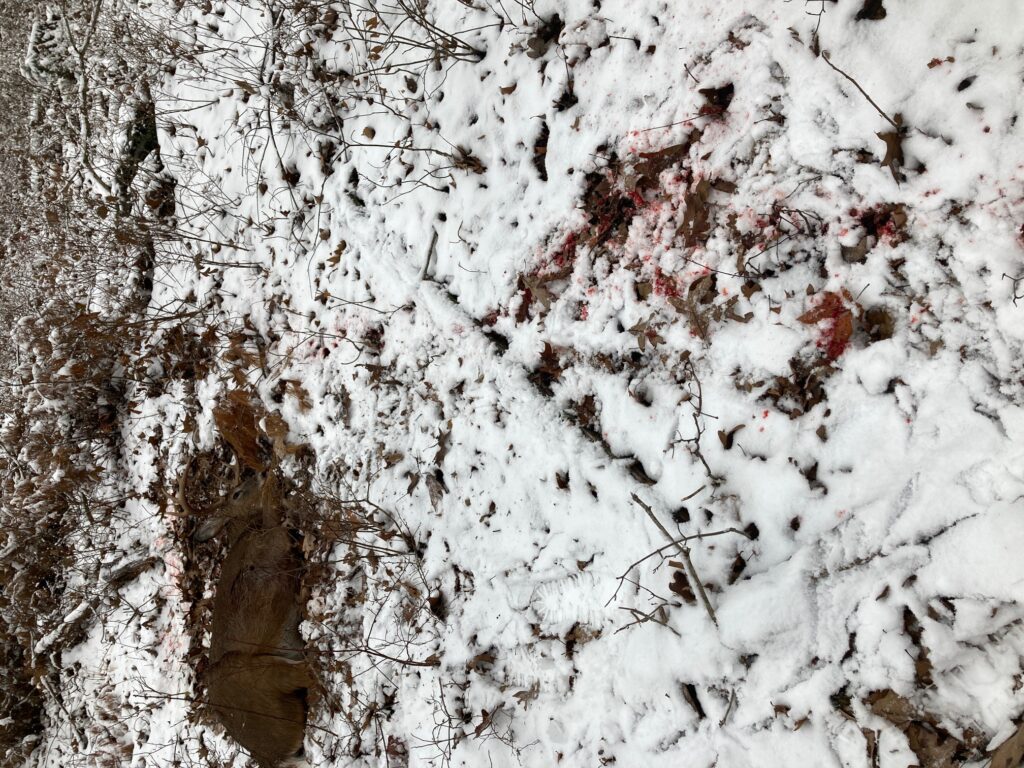
My challenge was that I did not see him fall, which happened while I was fumbling with my binoculars. Because I do not often use a rifle scope, I do not maintain a magnified field of view after my shot. Going back and forth between open sights and binoculars is my process.
As an aside, you may wonder why I use open sights, or you may be one of those people who deride open sights. Shooting instinctively with open sights is how I grew up and how I learned to hunt. Unlike a scope, open sights can take a lot more abuse in the field before they go out of whack. Unlike a scope, they cannot possibly lose their “zero” after spending eleven months in a closet. Open sights are absolutely reliable, and perfectly effective. Recall that American infantry are qualified on open sights out to 600 yards (or meters), so it is not like these things are relics from the past. Open sights are the best option, provided they are installed correctly and checked annually.
My preference for open sights is about more than performance, however. It has to do with how I like to hunt: On foot, getting close to the animal, within its sensory zone, and trying to kill it on its own terms, up close. This is a true contest of skill, not an assassination. And I hardly think an open-sighted center fire rifle is a disadvantage; it is a huge advantage over a spear or a bow. Scoped rifles are just that much more of an advantage.
So, I did not see the buck fall, and he fell into a small swale where I could not see him. Not wanting to stink up the woods and ruin further hunting, I sat on my butt and scoured the woods for signs of a deer. In fact, I saw a large buck a couple hundred yards away sneak into a thick tree top blowdown. It made me think the buck I had shot at was gut-shot and sneaking away to lie down, and so I did not push him. Only when the crows showed up over an hour later was it evident that the buck was in fact dead right where I had last seen him.

